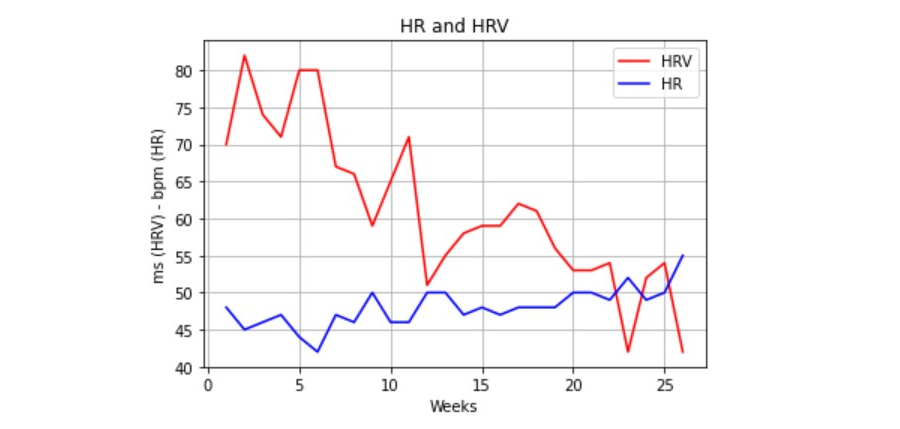Overtrained or Not? Movesense’s Enni Nurmi Uses HRV Analysis in Her Training

Using HRV analysis in identifying overtraining – Movesense trainee Enni Nurmi uses herself as a case example:
I’m Enni, a Finnish national team racewalker and Biosensing and Bioelectronics master student at Aalto University. I started as a summer trainee at Movesense at the beginning of May. At Movesense I can combine my knowledge from sport and studies with an important topic. However, as an elite athlete it’s not always easy to combine training, studying, and working. The last months have been challenging, which may indicate a loss of balance.
Elite athletes often train twice a day to reach their maximum performance. However, developing in sports is not that simple. As said, the whole must be balanced. Training, nutrition, and resting form three main pillars, not to mention mental health. In this text the focus is on training and recovery. Training can also be recovering but hard training sessions are needed for improving.
From hard training sessions, supercompensation is a desired outcome. If resting is repeatedly neglected, instead of developing, training can lead to overreaching and finally overtraining state.[1] In the overtraining state, athlete’s autonomous nervous system is imbalanced which can be seen from the heart rate (HR) and the heart rate variability (HRV).[1] HRV analysis is a useful tool for managing load and recovery and identifying possible imbalances.
After a hard training session, it is normal that HR increases and HRV decreases. However, HRV is more multidimensional. It can be divided into time-domain parameters, frequency-domain parameters, and nonlinear parameters. Maybe the most famous time-domain HRV values are root mean square of successive differences (RMSSD), standard deviation of the NN (R-R) intervals (SDNN(I)), the proportion of NN50 (the number of times successive heartbeat intervals exceed 50ms) divided by the total number of NN (R-R) intervals (pNN50) and their variations. Low frequency (LF) and high frequency (HF) power are the commonly used frequency-domain parameters and sample entropy (SampEn) is an example of nonlinear parameters.[2]
Many wearables, however, show only one HRV value which is the nocturnal average. Hynynen et al. stated that awakening HRV could provide more information about overtraining state while nocturnal heart rate has no correlation. They suggested SDRRI and LF power measured immediately after waking up as possible markers of overtraining.[1] Regardless, later studies also use nocturnal values for analyzing HRV changes.
Another study didn’t concern overtraining, but it gave information about nocturnal autonomic modulation and disturbance to homeostasis. Changes were recognized in HR, SDRRI, RMSSD, HF power and LF power measured after moderate training and maximal training.[3] Orthostatic tests are still used to evaluate athletes’ performance. For athletes that suffer severe overtraining state, LF power measured during the orthostatic test proved to be a reliable way to measure the status.[4]
I have been following my HR and HRV for several years. Lately, my HR values have been high and HRV values low. The featured image of the article shows my HRV and HR during 2023. For an athlete, the situation is really frustrating. Threshold tests don’t indicate any overtraining state, but could I still be overtrained?
I have now been resting more or less since March, without a single successful training week, which is not optimal for developing. Resting is hard when the World Championships are around the corner. The coming weeks will show if I’m racing there or not. Hopefully, I can soon measure my HRV parameters using Movesense sensor. I think that a commercially available sensor would be in the wishes of both over trained athletes and those who are aiming for their top level.
This text was written at the end of June. However, at the end of July it is sure that I will not race in the World Championships. The year has been mentally difficult, so it is time for the off season. Luckily, I have a nice job that gives me something else to think about. Flexible working hours and suitable amount of challenges fill my days nicely so that recovering is not disturbed.
References
[1] Hynynen, E., Uusitalo, A., Konttinen, N. and Rusko, H. 2006. Heart rate variability during night sleep and after awakening in overtrained athletes. Medicine & Science in Sports & Exercise, 38(2), pp.313-317.
[2] Järvelin-Pasanen, S., Sinikallio, S., Tarvainen M,P. 2018. Heart rate variability and occupational stress — systematic review. Industrial Health. Vol. 56, pp.500-511.
[3] Hynynen, E., Vesterinen, V., Rusko, H. and Nummela, A. 2010. Effects of moderate and heavy endurance exercise on nocturnal HRV. International journal of sports medicine, 31(06), pp.428-432.
[4] Hynynen, E., Uusitalo, A., Konttinen, N. and Rusko, H. 2007. Cardiac autonomic responses to standing up and cognitive task in overtrained athletes. International journal of sports medicine, 29(7), pp.552-558.
